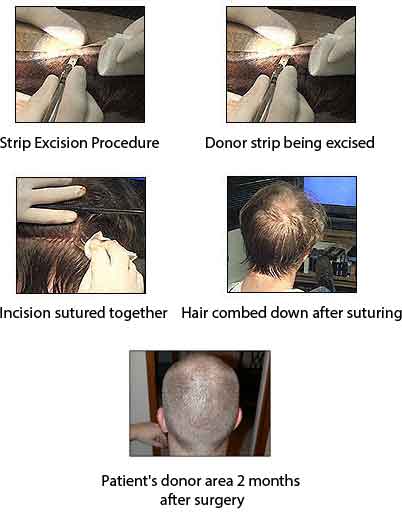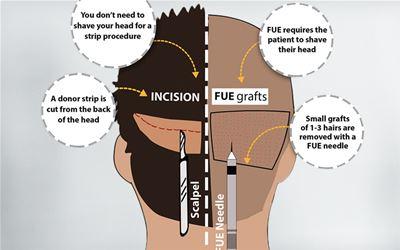
Despite misconceptions often made by patient members of our popular hair loss forum, FUT and FUE aren't opposing hair transplant procedures. FUT stands for Follicular Unit Hair Transplantation which is today's gold standard hair procedure. Follicular units are hair groupings as they occur naturally in the scalp typically containing 1, 2, 3 and 4 hairs. FUT has replaced "mini-grafting" (more than one follicular unit typically in groups of 2 to 8 hairs) as the dominant surgical hair restoration procedure in the late 1990s.
Follicular Unit Extraction (FUE) and Strip Excision are two distinct sub-types of FUT that deal with how follicular unit grafts are harvested from the donor area. Both donor harvesting methods produce follicular units and thus, fall under the larger umbrella of FUT. How follicular units are handled and the process for implanting grafts into recipient sites are practically the same (although handling and placing grafts vary depending on the clinic - ex: stick and place versus pre-made incisions, holding solutions, varying implanting devices, etc).
The above referenced donor harvesting techniques (strip excision and FUE) are what is really being compared when FUT vs FUE is referenced. Below, we compare these two donor harvesting methods in more detail.
Comparing Follicular Unit Extraction (FUE) to the Standard Strip Procedure
While the FUE procedure has grown in popularity, largely due to the minimally invasive way in which follicular unit grafts are removed, the standard strip excision method is still the most popular hair transplant procedure today.
The standard strip excision method involves surgically removing a strip of scalp from the bald resistant donor area of the patient. The donor area is then sutured together.
These sutures (either stitches or staples) are then removed about ten days after surgery. Some physicians use dissolvable sutures so that no removal is needed.
When the linear incision is fully healed the patient is left with a thin scar in the back of the head. This scar is typically hard to see once the surrounding hair grows out and conceals.
View the below video to see how the follicular unit excision (formerly known as follicular unit extraction) (FUE) hair transplant procedure is different than standard strip excision hair transplant surgery.
FUE or Strip Excision, which procedure is right for you?
Both the FUE and the Strip Excision procedures have advantages and disadvantages, which have often been debated on our hair restoration discussion forum.
The strip excision procedure is more economical (typically half the price per graft of FUE) and also enables a patient to move much larger numbers of grafts/hairs to the balding areas during a single surgical session. However, the donor area after a strip excision surgery will require more time before it is fully healed when compared to the FUE surgery.
In addition, the FUE procedure, given its minimally invasive nature, does not produce one long linear scar but rather hundreds of tiny scars in the donor area that are often hard to detect. This has fueled interest in the FUE procedure with patients who are highly concerned about potential visible scarring in the donor area.
However, given recent advances and care in donor closure techniques used during strip excision surgery, such as the trichophytic closure technique, the linear donor scar created by the strip excision procedure is now often almost undetectable, even upon close examination.











